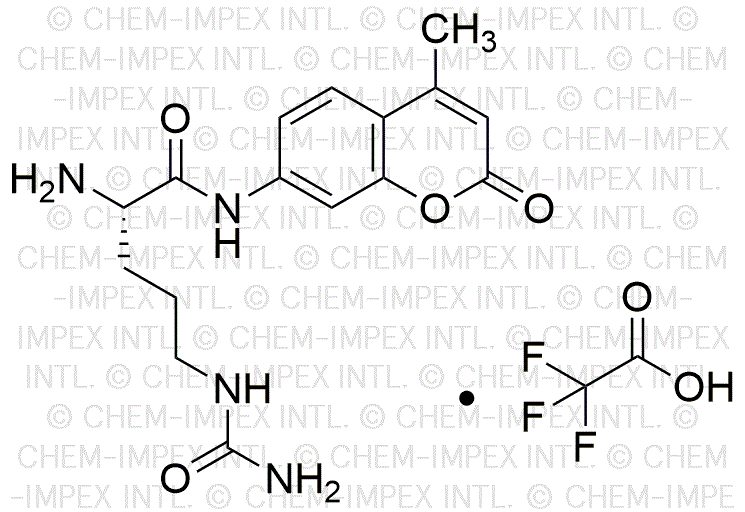H-Cit-AMC trifluoroacetate salt is widely utilized in research focused on:
- Biochemical Assays: This compound serves as a substrate in enzyme assays, particularly for proteases, allowing researchers to measure enzyme activity with high specificity and sensitivity.
- Drug Development: It plays a crucial role in the pharmaceutical industry for screening potential drug candidates that target specific enzymes, aiding in the identification of effective therapeutic agents.
- Diagnostics: The compound is used in diagnostic kits to detect enzyme-related diseases, providing valuable information for patient management and treatment decisions.
- Research on Cancer: H-Cit-AMC trifluoroacetate salt is employed in cancer research to study proteolytic enzymes that are often overexpressed in tumors, helping to understand tumor biology and progression.
- Protein Interaction Studies: It is utilized in studies examining protein-protein interactions, contributing to the understanding of cellular processes and signaling pathways.
General Information
Properties
Safety and Regulations
Applications
H-Cit-AMC trifluoroacetate salt is widely utilized in research focused on:
- Biochemical Assays: This compound serves as a substrate in enzyme assays, particularly for proteases, allowing researchers to measure enzyme activity with high specificity and sensitivity.
- Drug Development: It plays a crucial role in the pharmaceutical industry for screening potential drug candidates that target specific enzymes, aiding in the identification of effective therapeutic agents.
- Diagnostics: The compound is used in diagnostic kits to detect enzyme-related diseases, providing valuable information for patient management and treatment decisions.
- Research on Cancer: H-Cit-AMC trifluoroacetate salt is employed in cancer research to study proteolytic enzymes that are often overexpressed in tumors, helping to understand tumor biology and progression.
- Protein Interaction Studies: It is utilized in studies examining protein-protein interactions, contributing to the understanding of cellular processes and signaling pathways.
Documents
Safety Data Sheets (SDS)
The SDS provides comprehensive safety information on handling, storage, and disposal of the product.
Product Specification (PS)
The PS provides a comprehensive breakdown of the product’s properties, including chemical composition, physical state, purity, and storage requirements. It also details acceptable quality ranges and the product's intended applications.
Certificates of Analysis (COA)
Search for Certificates of Analysis (COA) by entering the products Lot Number. Lot and Batch Numbers can be found on a product’s label following the words ‘Lot’ or ‘Batch’.
*Catalog Number
*Lot Number
Certificates Of Origin (COO)
This COO confirms the country where the product was manufactured, and also details the materials and components used in it and whether it is derived from natural, synthetic, or other specific sources. This certificate may be required for customs, trade, and regulatory compliance.
*Catalog Number
*Lot Number
Safety Data Sheets (SDS)
The SDS provides comprehensive safety information on handling, storage, and disposal of the product.
DownloadProduct Specification (PS)
The PS provides a comprehensive breakdown of the product’s properties, including chemical composition, physical state, purity, and storage requirements. It also details acceptable quality ranges and the product's intended applications.
DownloadCertificates of Analysis (COA)
Search for Certificates of Analysis (COA) by entering the products Lot Number. Lot and Batch Numbers can be found on a product’s label following the words ‘Lot’ or ‘Batch’.
*Catalog Number
*Lot Number
Certificates Of Origin (COO)
This COO confirms the country where the product was manufactured, and also details the materials and components used in it and whether it is derived from natural, synthetic, or other specific sources. This certificate may be required for customs, trade, and regulatory compliance.


